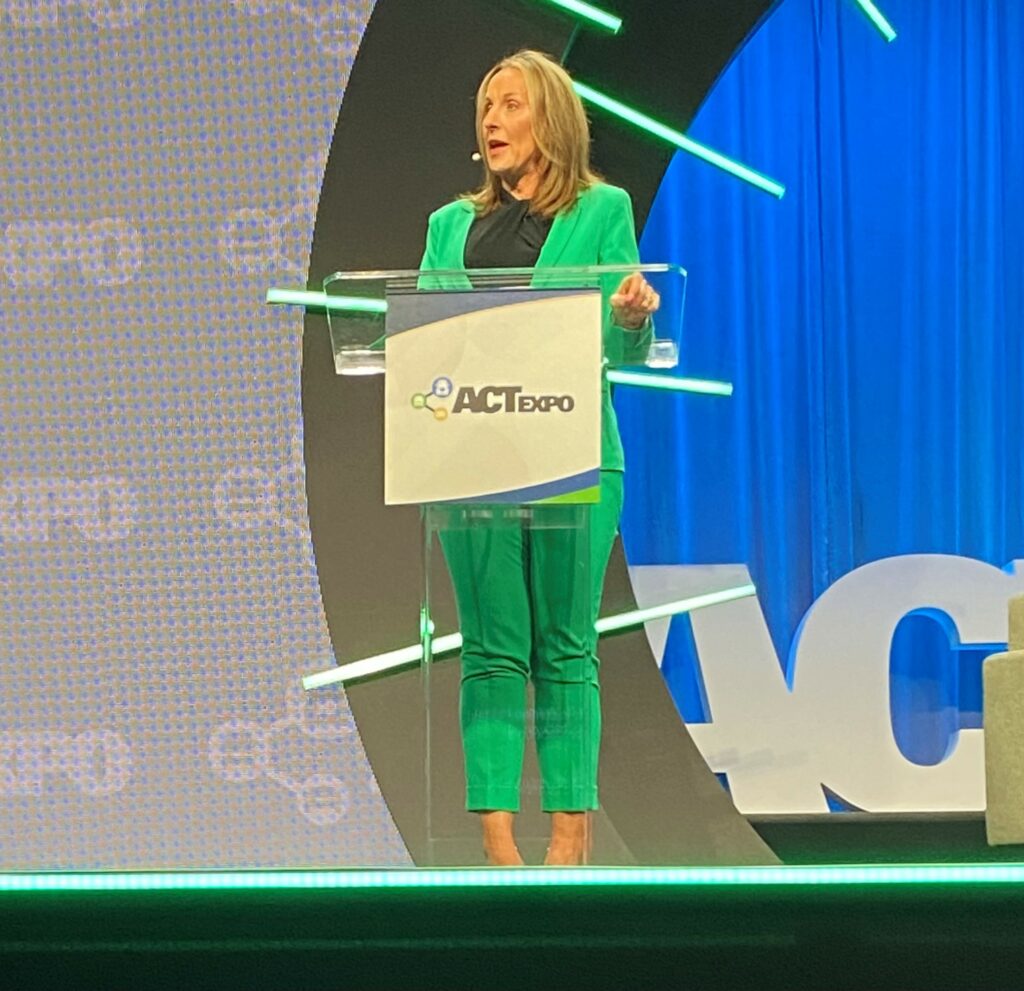J.B. Hunt president casts doubt on electrification, shares more cost-effective ways to decarbonize
If J.B. Hunt was to electrify its entire fleet of trucks, it would require the electricity draw consumed by 1.4 million households – or 1% of the entire U.S.
“Who’s willing to give their electricity up to power their home, for us to charge our entire fleet?” That was the sobering question posed by Shelley Simpson, president of J.B. Hunt Transport Services, speaking at ACT Expo. “Imagine what it would take to power all the electric vehicles in the U.S., in addition to all the passenger vehicles.”

She said it’s estimated the U.S. would have to increase its electricity production by 40% to charge all registered vehicles in the country.
While Simpson was candid about the prospects for electrifying the trucking industry, she was more optimistic about other ways of reducing trucking’s carbon footprint. J.B. Hunt itself is looking to reduce its environmental impact by 32% by 2034. It has a three-pillar strategy consisting of alternative equipment, biogenic fuels, and improvements in fuel economy.
Alternative fueled equipment poses the biggest challenge, with the cost of trucks being three times that of existing diesel models. They also introduce operational inefficiencies such as reduced range, long charging times and up to 12,000 lb. in additional weight.
“This often results in a necessity for us to add more zero emission vehicles to perform the same amount of work currently being performed by diesel trucks,” said Simpson. While she said it’s not economically viable to introduce more zero emission vehicles into its fleet at this time, she acknowledged, “it’s important to test and pilot these technologies.”
Watching closely
“We are watching this technology closely,” she said. “Our expectation is the technology and [charging] infrastructure will mature enough to make the case for economic adoption in the future. The benefits have to increase, and the costs decrease.”
J.B. Hunt now derives 24% of its fuel from renewable sources at cost near parity with diesel. This has helped it achieve a 16% reduction in its carbon emission intensity, achieving half of its 32% goal from a 2019 baseline.
Improved fuel economy has also helped it approach its targets. The fleet has an average tractor age of 2.3 years, allowing it to take advantage of the latest technologies. It spec’s all aerodynamic options, governs its speed, and employs cab heaters and automated manual transmissions.
“All improve greatly our fuel economy,” Simpson said.
Shippers have role to play
However, Simpson noted customers also have a role to play in reducing transportation’s carbon footprint. J.B. Hunt has created proprietary tools to help its customers understand their carbon emissions and to offer methods of reducing it. They are met with mixed reaction. An option to offset emissions with the purchase of carbon credits has not been accepted by a single customer, Simpson said.
Many customers are interested in moving their freight with zero emission vehicles, but are surprised to learn the overall carbon intensity – when taking into account that involved in producing the vehicles and their electricity – is not drastically reduced.
“Through discussions they’re often surprised when we talk with them about the carbon intensity relative to the cost of putting together some of those solutions,” she said.
J.B. Hunt measures dollars spent per metric ton of carbon reduced. Sometimes, simpler solutions such as mode conversion, the use of biogenic fuels and route optimization are the most effective – and cost-effective – ways to slash emissions.
Its 360 tools for shippers and carriers eliminated 3.5 million empty miles last year, Simpson said.
She walked ACT Expo attendees through an example of how a shipper can slash its carbon footprint in half based on moving 250,000 loads a year.
Shifting 30% of loads to intermodal cuts emissions by 20% and costs by15% with zero cost to convert. She said the railways have taken great strides in adding capacity and improving service levels to deliver truck-like service. Simpson estimates 7-11 million shipments could be switched to intermodal today.
Swapping 15% of diesel to biofuels can deliver another 10% reduction in carbon footprint with minimal costs. Simpson said using renewable natural gas for just 15% of that freight nets an 8% carbon reduction.
“Here’s where we get expensive,” she said, suggesting 10% of the freight could be moved by battery-electric vehicles, resulting in just a 3% carbon footprint reduction. Carbon credits – typically at a cost of $5-$50 per metric ton – can be used to get the rest of the way to a 50% reduction in carbon footprint for this sample shipper.
“Some of these solutions are not available everywhere or appropriate for certain types of freight,” Simpson acknowledged. “It’s going to take a mix of solutions to be economically viable in the pursuit of sustainability. It will take all of us working together to create economically viable sustainable solutions that really drive value.”
She also urged fleets to internally develop a cost of carbon to influence decision making.
Have your say
This is a moderated forum. Comments will no longer be published unless they are accompanied by a first and last name and a verifiable email address. (Today's Trucking will not publish or share the email address.) Profane language and content deemed to be libelous, racist, or threatening in nature will not be published under any circumstances.
A good article showing an industry insider speaking plain language about carbon reduction options. This is leadership on a topic that sorely needs it, so good for her and JB Hunt.